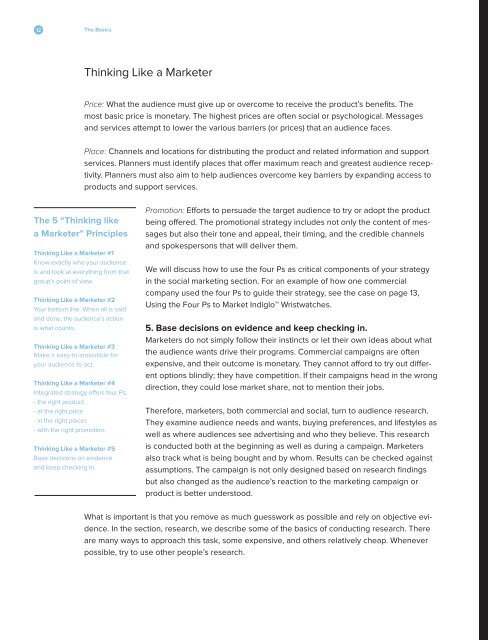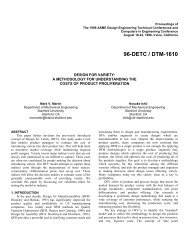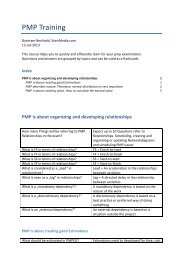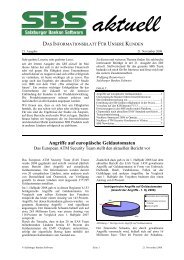Social Marketing
You also want an ePaper? Increase the reach of your titles
YUMPU automatically turns print PDFs into web optimized ePapers that Google loves.
12<br />
The Basics<br />
The 5 “Thinking like<br />
a Marketer” Principles<br />
Thinking Like a Marketer #1<br />
Know exactly who your audience<br />
is and look at everything from that<br />
group’s point of view.<br />
Thinking Like a Marketer #2<br />
Your bottom line: When all is said<br />
and done, the audience’s action<br />
is what counts.<br />
Thinking Like a Marketer #3<br />
Make it easy-to-irresistible for<br />
your audience to act.<br />
Thinking Like a Marketer #4<br />
Integrated strategy offers four Ps:<br />
- the right product<br />
- at the right price<br />
- in the right places<br />
- with the right promotion.<br />
Thinking Like a Marketer #5<br />
Base decisions on evidence<br />
and keep checking in.<br />
Thinking Like a Marketer<br />
Price: What the audience must give up or overcome to receive the product’s benefits. The<br />
most basic price is monetary. The highest prices are often social or psychological. Messages<br />
and services attempt to lower the various barriers (or prices) that an audience faces.<br />
Place: Channels and locations for distributing the product and related information and support<br />
services. Planners must identify places that offer maximum reach and greatest audience receptivity.<br />
Planners must also aim to help audiences overcome key barriers by expanding access to<br />
products and support services.<br />
Promotion: Efforts to persuade the target audience to try or adopt the product<br />
being offered. The promotional strategy includes not only the content of messages<br />
but also their tone and appeal, their timing, and the credible channels<br />
and spokespersons that will deliver them.<br />
We will discuss how to use the four Ps as critical components of your strategy<br />
in the social marketing section. For an example of how one commercial<br />
company used the four Ps to guide their strategy, see the case on page 13,<br />
Using the Four Ps to Market Indiglo Wristwatches.<br />
5. Base decisions on evidence and keep checking in.<br />
Marketers do not simply follow their instincts or let their own ideas about what<br />
the audience wants drive their programs. Commercial campaigns are often<br />
expensive, and their outcome is monetary. They cannot afford to try out different<br />
options blindly; they have competition. If their campaigns head in the wrong<br />
direction, they could lose market share, not to mention their jobs.<br />
Therefore, marketers, both commercial and social, turn to audience research.<br />
They examine audience needs and wants, buying preferences, and lifestyles as<br />
well as where audiences see advertising and who they believe. This research<br />
is conducted both at the beginning as well as during a campaign. Marketers<br />
also track what is being bought and by whom. Results can be checked against<br />
assumptions. The campaign is not only designed based on research findings<br />
but also changed as the audience’s reaction to the marketing campaign or<br />
product is better understood.<br />
What is important is that you remove as much guesswork as possible and rely on objective evidence.<br />
In the section, research, we describe some of the basics of conducting research. There<br />
are many ways to approach this task, some expensive, and others relatively cheap. Whenever<br />
possible, try to use other people’s research.

















